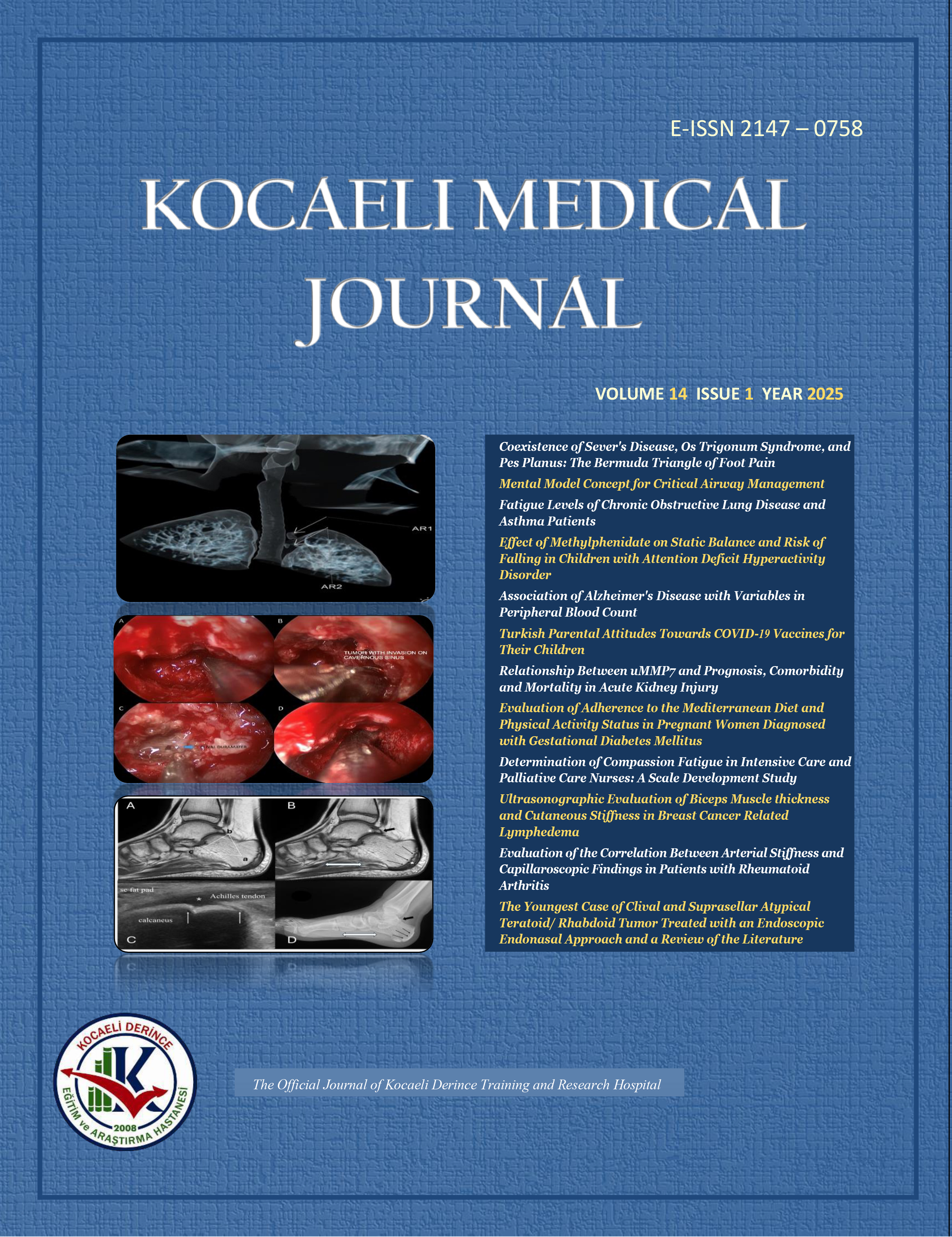
Volume: 3 Issue: 3 - 2014
| ORIGINAL ARTICLE | |
| 1. | Overview to cesarean birth in Turkey in accordance with cesarean rate and indications in our hospital Hüseyin Aksoy, Sezin Özyurt, Ülkü Aksoy, Gökhan Açmaz, Özge İdem Karadağ, Mustafa Alparslan Babayiğit Pages 1 - 7 OBJECTIVE: We compared the number of vaginal deliveries with cesarean section deliveries in 2013 in our tertiary care clinic and determined the rate of cesarean indications, lengths of operations, and anesthesia technique chosen for the cesarean deliveries to ascertain our fit within the WHO standards. METHODS: We retrospectively evaluated 2736 patients whose babies were delivered by cesarean section out of a total of 6765 births. The indications for cesarean section, lengths of operations, and anesthesia methods were recorded. RESULTS: Of the 6765 births, 4029 (60%) normal vaginal births and 2736 (40%) cesarean births occurred in the one-year period. The most common indication for cesarean delivery was previous uterine surgery (46%), followed by fetal distress (16%) and cephalo-pelvic disproportion (11%). Regional anesthesia was performed in 89% and general anesthesia was used in 11% of the cesarean births. CONCLUSION: Although our hospital is a reference tertiary care clinic, our cesarean rate (40%) is lower than that in Turkey (58.6%). Most cesarean deliveries were indicated by previous uterine surgery, so a key way to reduce them is to decrease the number of primary cesarean deliveries. |
| 2. | The Frequency Of Tendency For And Exposure To Vıolence Among The Young Populatıon In Elazıg Provınce, Its Factors And Relatıon To Anger Murat Aygen, Yasemin Açık Pages 8 - 17 OBJECTIVE: This study was carried out to determine the frequency of propensity for and exposure to violence among the young population in Elazig. METHODS: 1463 subjects have been selected from 22480 students attending to these high schools,and the response correlation has been 99.2%.In the study, State-Trait Anger Scale developed by Spielberger has been used in addition to the questions measuring the frequency of stronging arm and being exposed to it. RESULTS: The age-average of the subjects in the study was 15.33±1,046 and 49.3% of them were male.10.3% of them have confessed that they have been smoking,6.5% drinking alcohol, 4.9% taking drugs and 9.0% carrying stab.Of the subjects included in the study;12.2% have implied that they still have been exposed to physical,20.7% to sensual,3.2% to sexual violence. 31.7% of the subjects have expressed that they have commited physical violence, 41.5% sensual violence,20.6% sexual violence. While the permanent-anger, inner-anger,outer-anger points of the ones being exposed to the physical violence have been higher (p<0.05) than the ones not exposed,it has not been determined a significant correlation with respect to the ones being exposed to the verbal and sexual violence (p<0.05). CONCLUSION: Consequently, the correlation of committing and being exposed to violence among the high school students in Elazıg is too high. A positive correlation is in question between the anger-points and committing the violence. |
| 3. | Patients taking warfarin who had visited an internal medicine clinic and success rate in achieving target INR. Selçuk Yaylacı, Altuğ Ösken, Ercan Aydın, Ahmet Bilal Genç, Salih Şahinkuş, Yusuf Can, Mustafa Volkan Demir, İbrahim Kocayiğit, Ceyhun Varım Pages 18 - 21 OBJECTIVE: In our study, the objective was to investigate the demographic data of patients taking Warfarin who had been followed up in an internal medicine clinic and to analyze the factors affecting the success in achieving the target INR. METHODS: The follow-up forms, prepared for the patients taking anticoagulant therapy in internal medicine clinic, were screened retrospectively. The data were analyzed statistically. RESULTS: In the study, 57 patients taking oral anticoagulant therapy were included. The mean age was 71±11 (59.6% was female). The success rate in achieving the target INR levels was found to be 52.6% (30 patients). Of the patients, 91.2% reported that they had been informed about the drugs, 92.9% was taking drugs regularly, 82.4% had regular INR controls, 54.3% knew the target INR range, and 71.9% was informed about the complications. No statistically significant difference was found between the parameters of patient groups who had reached the target INR and who hadn't. CONCLUSION: In our study, the low success rates in reaching the target INR in patients taking oral anticoagulant agents was also noteworthy. Therefore, we suggest that the knowledge of patients taking an oral anticoagulant therapy should be increased, and we think that the new generation oral anticoagulant drugs can be administered, instead of Warfarin, to the patients who were unable to maintain the INR despite the adequate training. |
| 4. | Role of ultrasound elastography in the differential diagnosis of benign and malignant thyroid nodules Gökhan Duygulu, Tülay Özer, Hakan Cebeci, Çağrı Tiryaki, Murat Coşkun, Ahmet Tuğrul Eruyar Pages 22 - 26 OBJECTIVE: The purpose of this study was to evaluate the diagnostic utility of ultrasound elastography in differentiating benign from malignant thyroid nodules. METHODS: A total of 52 consecutive patients who were referred for thyroid fine needle aspiration biopsy were examined in this study. 56 thyroid nodules in these patients were examined by B-mode ultrasound and ultrasound elastography. The final diagnosis was obtained from histologic findings.Tissue stiffness on US elastography was scored from one (greatest elastic strain) to five (no strain). RESULTS: On real-time ultrasound elastography, 48 of 49 benign nodules had a score of 1 to 3, 5 of 7 malign nodules had a score of 4 to 5 (p<0.05), with sensitivity of 71%, specificity of 97%, a positive predictive value of 83%, and a negative predictive value of 68%. CONCLUSION: Ultrasound elastography is a usefull imaging technique in the differential diagnosis of thyroid cancer. |
| CASE REPORT | |
| 5. | Dysembryoplastic neuroepithelial tumor of cerebellum in a child Doğan Köse, Erdal Kalkan, Yahya Paksoy, Hatice Toy, Nurcan Üçüncü Ergün, Yavuz Köksal Pages 27 - 31 Dysembryoplastic neuroepithelial tumors are benign neoplasms with typical supratentorial location. 12 year old patient, who applied to a local hospital with complaints of loss of consciousness and postural tonus, was referred to our hospital with cerebellar mass diagnosis. According to the anamnesis, similar complaints also appeared when the patient was 3 and 10 years old, however no anomaly was found in the examinations done by pediatric cardiologist and pediatric neurologist in that period. Physical examination and routine laboratory examinations of the patient were normal. The mass identified in the cerebellum was totally removed. The patient was diagnosed as dysembryoplastic neuroepithelial tumor by histopathological evaluation of the tissue. The patient has still been under outpatient follow-up and in complete remission without any evidence of recurrence for 5 years. In this report a child patient having dysembryoplastic neuroepithelial tumor with cerebellar location is aimed to be shared with the literature. |
| 6. | Anaesthetic management of a patient with latex allergy Elif Atar Gaygusuz, Sema Öncül, Efe Önen Pages 32 - 34 Medical products contain latex are present in our environment, especially in the hospital setting. Difficulties in the administration of general anaesthesia to the patients with latex allergy were recognized and managed accordingly. Here we aimed to report our anaesthetic management of a patient with latex allergy. |
| 7. | Partially Defect of Atlas Posterior Arcus; Case Report Hakan Cebeci, Gökhan Duygulu, Tülay Özer, Soner Şahin Pages 35 - 38 Congenital posterior fusion defects of atlas are rare and usually asymptomatic developmental anomalies. It is clinically important in some cases because of associated neurological symptoms. In this case report, we aimed to present computed tomography findings of 6 years old girl admitted to emergency room after trauma and detected left posterior arcus defect of atlas in radiological examinations accompanied by literature findings. |
| REVIEW ARTICLE | |
| 8. | Evidence Based Treatment of Sudden Hearing Loss Halil Erdem Özel, Selahattin Genç, Fatih Özdoğan, Erkan Esen, Adin Selçuk Pages 39 - 47 Introduction: Sudden hearing loss is defined as a sensorineural hearing deficiency that develops rapidly over a maximum of 3 days, a minimum of 30 dB of hearing deficiency at three adjacent frequencies where clinical assessment fails to reveal a cause. Appropriate treatment in sudden hearing loss is still in search. The more common therapeutic approach involves the use of steroids, hyperbaric oxygen, vasoactive substances and antivirals. Based on the most of the studies, all these options seems to have favorable effects on hearing, but the clinical significance of the level of improvement is not clear. The objective of this paper was to review the literature and develop an evidence-based treatment of sudden hearing loss. Materials and Methods: Recent studies have been reviewed subject to the treatment of sudden hearing loss. Conclusion: It is difficult to interprete the results because of the variations in the practice of treatments applied and the use of combined treatments in each study. In addition to efforts to clarify the etiology of sudden hearing loss, randomized controlled trials performed on specific patient groups comparing a single type of treatment versus placebo of sudden hearing loss is needed in order to generate an evidence-based treatment protocol for sudden hearing loss. |












